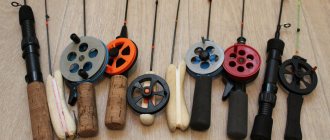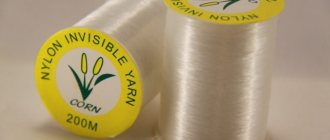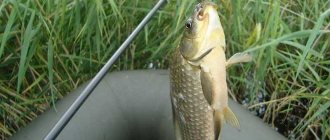How to choose a spinning reel
Let's immediately agree that we are now considering spinning tackle. It’s just that there is also casting tackle (with a multiplier), which we also often call “spinning”. In other words, below we will only talk about spinning reels. We'll look at multipliers another time.
When an angler is faced with the question of choosing a spinning reel, he must make a decision on several points, namely: size, weight, line capacity, gear ratio, location of the friction brake, the presence or absence of an additional spool, affiliation with a particular brand and, finally, the price.
How to choose a cheap, high-quality spinning reel. Photo. Video.
This article talks about how to choose the right budget spinning fishing reel and what points you should pay special attention to.
It so happens that fishing practice in most cases requires the presence of a spinning reel. If you are a fan of, for example, only feeder fishing, then 2-3 reels are enough for you. They can be bought from brands for “good” money. But if you need much more and don’t feel like spending money, then you can buy reels in the medium and low price range. Or you need a coil as a spare.
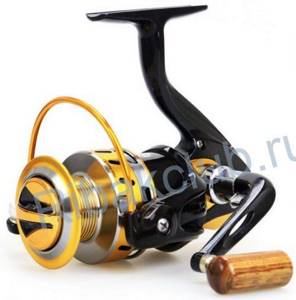
How to choose a budget reel?
We go to the store and look at the suitable options by price and size.
Do not listen to the seller who starts telling you about sizes: 1000, 2000, 3000 series, etc. On the spool (where the fishing line is wound), as a rule, it is indicated how many meters of fishing line of a given section are used, how much you need and take.
The number of installed bearings (“ball bearing”) and the gear ratio of this reel (1:5.1) are also written on the spool. The gear ratio means that in one revolution of the handle, the line-laying arm will travel, for example, 5.1 circles. The greater the difference, the faster the line will reel in. Have you read it? Let's check. We put the handle in the position opposite the reel leg (up), smoothly turn the handle and count the revolutions of the bow to ourselves.
Next we check the bearings. Cheap ones usually say 10 or more pieces (this should alert you), but in reality there may only be one. For a cheap reel, the most important thing is that there are at least 3-4, at worst, so that there are bushings. But the seller won’t let you disassemble the coil, what should I do? There are some signs of the presence or absence of bearings that work and have helped the author out more than once.
More details
If any number of bearings with “+1” is written on the reel , then this means that this model must have an instantaneous overrunning clutch. Secure the reel handle properly, turn on the brake (not to be confused with the clutch), turn the handle forward, then back. If the handle has a slight backward movement, then you do not have this bearing. And vice versa, if the handle locks and stops like a glove without the slightest move back, then everything is fine.
It might be like this
Look at the line roller and landing sockets. If they do not have a metal insert (the bolt should be wrapped in a metal axle, not a plastic one), then most likely the roller does not have a bearing or bushing.
Remove the handle
Remove the handle from the reel and look carefully at the holes where it stood. If you look closely, you can see either a metal bearing, a white-gray plastic bushing, or a continuation of the housing (the most undesirable).
Bearing
The bearing can be located in the bobbin mechanism. This can be easily checked by removing the spool and turning it over to look inside.
If there are bearings in all the above places, then this is a good start. If there are bushings somewhere, then if you wish (especially if you buy many of the same type of reels at the same time), you can order bearings from Aliexpress or similar stores, according to the size of the bushings.
So, we have checked the presence of bearings, now we will put the handle in place and carry out some more manipulations.
Twist the reel handle, holding it in front of your face as tightly as possible. This is necessary in order to check how smoothly the axle moves. If the spool dangles from side to side, then ask for another sample; if the same thing happens to you, look for another reel, because... when winding quickly, there will be a terrible vibration, which will soon break the mechanism.
Friction clutch
Shade the clutch and try to twist the spool (how tightly), release the clutch to see if the spool dangles a lot (up and down and to the sides). If the reel has a top clutch, unscrew the nut (with a ratchet). Look at what material it is made of: if it is plastic, then the ratchet will be in the form of a plastic plate (usually enough for a season), and if it is metal, then the plate will also be made of metal inside.
Shade the handle and check how tightly it fits and whether the threads hold well. The screw should tighten immediately and not fall through.
Do not forget
And finally. If the seller reproaches you for thoroughly checking cheap tackle when purchasing, saying: “... it costs nothing, and here you are looking at...” - do not pay attention to him. Don’t pay your money to dishonest manufacturers, maybe they will at least think about quality.
Good luck with your choice!
Price list
The last point, however, deserves to be put first. Usually we start from the amount we can afford, and only then resolve all other issues. Therefore, let's start with the financial aspect. How to choose a reel by price?
To a person far from fishing, all spinning reels seem almost the same. It is impossible for him to understand why one reel costs 1000 rubles, and the other costs almost 100,000? Actually, even to a more or less experienced fisherman, such a price “fork” seems absurd. Well, if only because for a hundred thousand you can actually buy an old, but running car... And here is some kind of coil.
Let’s still not take into account reels with a frankly “anti-people” price tag. I will simply limit myself to the observation that they do not carry any super advantages. For the vast majority of us, the question of “financial” choice lies in the range of approximately two to ten to fifteen thousand rubles.
At the moment, we can say that reels of the most budget level (about 2-4 thousand rubles) are quite functional and, with careful use in “weekend” fishing mode, are designed for several seasons. About 10 years or more ago, the corresponding price segment, specifically in relation to spinning rods, was, one might say, a failure. The cheap reels of that time were suitable for fishing rods, donkeys, etc., but not for spinning rods. But in recent years, the budget manufacturer has greatly improved both in design and performance.
What do we get if we increase the price tag two or three times? It would not be entirely correct to think that the service life of the coil will increase by the same amount. Although we have the right to certain expectations in this regard. Reels in the price segment of 5-10 thousand rubles, this, as a rule, means less weight, plus a smoother ride (due to the number and quality of bearings). By the way, I myself most often fish with reels in this particular price range. Which is probably very significant.
Advantages and disadvantages of inertia
What are the pros and cons of a drum reel? Its undoubted advantage is that its apparent simplicity is combined with reliability. If the inertia-free reel reacts painfully to a scratched side, then the drum can be bent and then straightened, and the reel will perform its service properly.
Speaking of disadvantages, we can note the low speed of rewinding the line. The same Neva model selects 0.33 m per revolution of the drum. There are reels with larger and smaller diameters, but do not forget that with its increase the mass also increases. We wrote about how to choose the right mechanism in the article “The best inertial reel for spinning rods in terms of characteristics.”
When trying to install a large drum on a fishing rod, inexperienced fishermen are sure that the reeling speed will increase significantly, and, most importantly, this will have a positive effect on the range of the tackle. However, not everything is so simple; you will have to get used to casting with a lot of weight.
Unfortunately, St. Petersburg residents never began to practice installing bearings on “nevki”, so they are more often used for vertical lures. But from imported ones you can buy a reel not only with two bearings, but also with a rotating drum on cones. With proper preparation, equipment with such a device can be thrown a good hundred meters.
Installing bearings somewhat complicated the mechanism and its perception of external stimuli. Sand and water, once inside, can damage the bearings if you do not react in time. In this case, it is necessary to dismantle the drum, rinse all elements thoroughly and lubricate them.
Do our fishermen use inertia? The presence of this product on store shelves exhaustively answers the question. There is even a Chinese inertial coil with bearings on sale, which means it is in demand. By the way, the Chinese produce them both with and without bearings, and it is possible to find very decent models.
Size and weight
There is no single system that reflects the size of spinning reels that their manufacturers would adhere to. But there is a so-called "thousands" scale, which is the most common. The point is this. Basic sizes are indicated by thousandth indexes. For example, 1000 is ultralight, 2500 is a medium-light to medium class, 4000 is a medium-heavy and heavy class. To a first approximation, this should be clear to a beginner. The “non-round” designations are somewhat more difficult to understand. For example, how should one perceive the size of the 2004 reel, which is available from Daiwa and some others? In fact, this reel has a size of 2000, only it is equipped with a low-capacity spool designed for thin braided cords. Therefore, in order not to make a mistake in your choice, pay attention to such a parameter as the line capacity of the spool. If you intend to fish only with braid, then reels with particularly capacious spools (for example, sizes 2500 and 200 m / 0.25 mm) should be considered secondarily.
By the way, size 2500 can be called the most universal. If your goal is to cover the maximum range of weights and sizes of lures with one reel, you should prefer it.
The weight of the reel is, of course, also important. The upper value of the weight of a reel for spinning tackle, depending on its “power class,” can be designated something like this. Ultralight (UL) – 200 g, light (L) – 230 g, medium-light (ML) – 260 g, medium (M) – 275 g, medium-heavy (MH) – 300 g, heavy (H) – 350 d. The lower value is usually not specified, but it is implicitly considered “the lower, the better” - of course, while maintaining the power parameters. Therefore, many obviously expensive reels are made of very light, but at the same time strong and durable materials. All this is good, but we must not forget about the balance of the tackle: a powerful, heavy rod does not always go well with a powerful, but light-weight reel.
Spinning reel parameters
To make the right choice, you need to know the necessary parameters of spinning reels. In some cases, you should pay attention to corrosion resistance, and in others, to the gear ratio.
When choosing, you need to pay attention to:
- material of main elements;
- number of bearings;
- weight;
- size;
- gear ratio;
- line laying mechanism.
Coil dimensions
If you need to choose the optimal reel size, you need to choose it depending on the size of the fishing line that will be used most often. The lighter the line, the smaller the reel should be. You should check the numbers on the reel to make sure it has the correct number (or product chart).
The next important factor when choosing a reel depends on the type of fish the fisherman plans to catch most of the time. This will help you know what type of reel is required to catch that particular species. There is no need to spend a lot of money on a corrosion-resistant reel unless you plan to fish in brackish or salt water.

You need to spend some time figuring out which specific species require a reel. The method of fishing is also an important factor to consider when making a purchase. Fishermen fishing from a boat will have a movement advantage when fighting fish. The ability to move freely with a struggling fish reduces stress on the reel. On the other hand, fishermen who fish from the shore or pier will need to select gear that is suitable for this method.
Spinning fishing reels are generally divided into 3 categories: small, medium and large reels.
Small reels are suitable for catching fish such as perch, chub and asp, as well as for light fishing in ports, rivers and lakes.
Mediums are ideal for lakes, bays, boat fishing and fishing for species such as walleye and pike.
Large ones are best suited for rock and boat fishing. They are great for catching salmon, salmon, tuna, catfish and trout.
Body and weight
The reel body (also called the body) can be made of aluminum or graphite - sometimes a combination of both materials. As you'd expect, aluminum cases are stronger than graphite and don't flex as often as graphite. On the other hand, graphite cases are lighter. This dictates the choice or preference between a stronger or lighter reel. Generally, brackish or salt water conditions require the use of a higher quality reel compared to fresh water.
Salt water reels are made from corrosion-resistant materials such as anodized aluminum, graphite, and stainless steel. These reels cost much more than fresh water reels. The highest quality freshwater spinning reels usually have aluminum bodies. However, if you plan to fish in saltwater, a graphite reel will be better suited for saltwater. In any case, you need to make sure that the case is well designed. This means that all mechanical parts must move smoothly and without jerking backwards.

The importance of weight when choosing a reel depends on fatigue. Obviously, the less weight an angler puts on his hand when fishing with a lighter reel, the less stress he will experience. This is a profitable option for people who spend a lot of time fishing. Long hours of fishing can be very tiring, especially if the reel you are using has extra weight. Whether fishing on the shore, offshore or in a local pond, a fisherman will need a reel that is lightweight and easy to use. Lightweight reels are easy to use and reduce wrist fatigue. Additionally, the lightweight reels are easy to use, have good balance, and are very comfortable for long days on the water.
It is important to make sure that when comparing reel weights, you are comparing reels of the same size.
Gear ratio
Gear ratio refers to the number of revolutions. Essentially, a reel with a 4:1 gear ratio will spin 4 times for every turn of the handle. A 4:1 reel is usually slow. On the other hand, a 6:1 ratio is a high-speed reel that is better suited for medium and small fish. If you have the budget to buy several reels with different gear ratios, this is the best way to optimally cover all situations. However, if your budget is tighter and you can only buy one reel, you should choose a medium-speed model (5:1 ratio).
Well-known brands like Shimano usually offer reels with different gear ratios to make them as comfortable as possible.
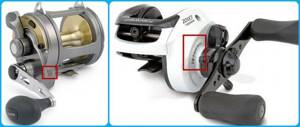
Reel Ball Bearings
Reels come with ball bearings (also called bushings) that are mounted inside the housing to provide support, stability, and smoothness to the reel. As a general rule, the more bearings a reel has, the better its performance will be. Stainless steel bearings are also preferred for their long life and controllability. You need to get a reel with the most ball bearings you can afford. The minimum number of bearings should be 4. The quality of the reel depends on the quality of the ball bearing used. Noise and vibration are signs of poor quality and can make fishing a frustrating experience. As a general rule, the more ball bearings a reel has, the smoother it will be. However, a 4-bearing drum is superior to a low-quality 10-bearing drum. It is not quantity that matters, but quality.
Budget should not be the main concern when it comes to this particular aspect as the number of bearings is of paramount importance.
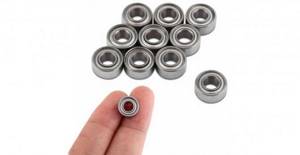
Reel quality
The quality of the reel will largely depend on the price. As a general rule, the more expensive the reel, the higher the quality and durability of its components. The internal components of a reel are an important thing to consider when making a purchasing decision. A spinning reel with high-quality internal parts will outperform a low-quality one and will also last for many years. But the inexperienced angler doesn't need to spend a lot of money on a reel, especially if he plans to hit the water several times a year.
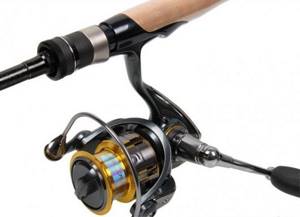
Friction brake
About 20 years ago or more, up to a third of spinning reels had a friction brake located at the rear. Now the share of “back-friction” reels in spinning rods has decreased to several percent. In principle, they are still produced quite en masse, but they are used more in float and bottom fishing. Why is that?
The rear clutch has two advantages over the front clutch. This is a little more convenient for operational regulation and the complete elimination of “self-tightening” (when, when the fishing line is released, the rotating spool carries the regulator nut with it). However, these two advantages are offset by one disadvantage: the front clutch is smoother and not prone to “sticking”, that is, it handles sharp jerks better. For spinning rods with a priority on braided cords, this is very important. Therefore, if the question arises: front clutch or rear clutch, choose the front one. Moreover, now there is an absolute majority of such reels.
Laying
The use of braided cords and jerking methods of wiring impose rather stringent requirements on the quality of winding the cord onto the spool. Without going into detail, the installation should be as smooth as possible without bumps or dips. The quality of the winding can hardly be assessed in advance. But it is useful to ask on any active fishing forum about the reel you are planning to choose.
There are so-called “closed” spinning reels, in which the spool is covered with a special protective cap.
Spare spool
If the reel comes complete with an additional spool, then most of us perceive this as a kind of bonus. Especially if the reserve spool differs from the main one in terms of line capacity. By purchasing such a reel, we get, as it were, “two in one”.
But not everything here is simple and obvious. Firstly, an additional spool is an addition to the price tag. On average, this is twenty percent. Secondly, the reel mechanism wears out the same way - whether we constantly fish with one spool or alternate two. Before buying a reel, consider whether it is worth paying extra for a spare spool?
"Branding"
Very often, when we make a decision to purchase not only a reel, but also, say, any household appliance product, the determining factor in our choice is the brand under which this very product is produced. If the brand, as they say, is well-known, then the likelihood that the purchase will take place is significantly higher than in the case when its name does not mean anything. At the same time, we often realize that we overpay for a well-promoted brand. We are willing to overpay, largely because we perceive brand recognition as a kind of informal guarantee of quality.
In relation to our current topic, this means this. There are expensive brands on the fishing market. For example, Daiwa and Shimano reels. Almost everyone who fishes at least a little and is interested in gear has probably heard about them. And such reels are more tempting for many of us. But you need to understand that these brands are expensive. The share of “brand markup” in Shimano and Daiwa products is slightly higher than in others. What follows from the above? And the fact is that if we are talking about the medium-expensive or expensive segment, then the question of choice comes down to the coils of these two “elite” brands. But in the more budget segments, I would direct you to more “popular” brands. These could be, for example, Stinger or Select, which have already proven themselves to be good. The case when it is better not to overpay...
How to choose a spinning reel for a beginner generalist spinning player?
1. Price category of the reel . If you are a “weekend” fisherman and there is no serious load on the gear, then you can opt for an inertia-free fishing rod that costs 2,000 – 4,000 rubles. For example, the Stinger ForceAge XW series. For more frequent and intensive use, a model from 5,000 to 10,000 is better suited. Legalis-12 2500 from Daiwa belongs to this price category.
2. Size of the spinning reel . Depends on the type of fishing. The higher the value, the heavier the class: 1000 is ultralight, 2500 is medium-light and medium, 4000 is medium-heavy, etc. Pay attention to the line capacity of the spool. The universal size for a beginner is 2500. It allows you to cover the maximum range of baits and weights.
3 . Reel weight . Depends on the type of fishing. It is selected according to the principle “the less the better”, but without loss of strength. Must match the weight of the rod.
4 . Gear ratio or reduction . The optimal average for a beginner is 5.0:1 (with slight deviations +/-).
5 . The friction brake of a spinning reel is front, it handles jerks better.
6 . Laying the line should be as even as possible. It is better to rely on the experience of other anglers in using a particular reel or expert opinion.
7 . Spare spool . Convenient for using fishing line (cords) of different diameters. Its presence in the package does not affect the service life of the reel, but as a rule, it increases the cost.
8 . Reel brand . Budget category: Stinger or Select. Higher price segment - Daiwa and Shimano.
9. Indexes and abbreviations.
Both beginners and even pros when choosing a spinning reel are faced with various abbreviations. Since there is no single classification, each brand may have its own abbreviations. We offer a cheat sheet on possible indexes:
The most common ones found among different manufacturers are:
Maintenance of closed type bearings with removable boots

- 1 - I use a rubber thread so as not to frantically search throughout the kitchen for retaining rings
- 2 - remove the locking ring with a needle
- 3 - the ends of small-diameter retaining rings with such bevels are difficult to remove; only by prying the right end with a needle, the left one will not pry off. By the way, I recommend that when assembling you orient it the same way as it was, so that you don’t have to rack your brains during repeated maintenance.
- 4 - boots and retaining rings - in a gasoline galosh (Nefras S2-80/120) (usually I wash everything in it, with the exception of rubber and some plastics). For the ShP, it is convenient to use caps from screen cleaner sprays as a “container”, and the central polyethylene plug of the lid of a 20-liter water bottle for a cooler is a good fit for the “container”.
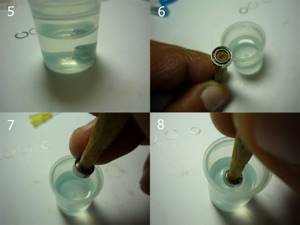
- 5 — the opened shp sours
- 6 - we plan a stick from pine with a slight taper of the required diameter. We wad the bearing
- 7 - unwind
- 8 - lower it into a gasoline galosh. Repeat many times, remove, put on the stick with the other side, repeat again
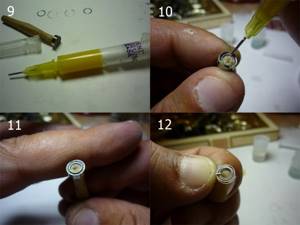
- 9 - we use thick lubricant (we are talking about low-speed spindles, used everywhere, with the exception of the support spools of the multis). It’s convenient for me to fill it with 2 mm syringes, onto which I put a thick sawed-off needle.
- 10 - we score from both sides. There is no need to fill it completely, 30-60% of the free volume is enough.
- 11 — roll the lubricant over the balls, races and separator, simply rotating the spindle
- 12 — put on the cover, checking the uniformity of the gap between the cover and the inner race of the shank, install the retaining ring (the elastic band will again protect you)

- 13 - snap the locking ring into place
- 14 - finite)
In general, nothing complicated or supernatural - a little desire, good lighting, good vision (glasses) and the absence of chronic alcoholism in the stage of shaking hands.
How many bearings and where should there be in a fishing reel?
Traditionally, we believe that the more bearings a reel has, the better. And you have to agree with this, because it is the ball bearings that ensure the smoothest running of the reel, which in turn largely determines the comfort of fishing.
Bushings, i.e. Sliding bearings are also functional, but due to their poorer wear resistance, various axial play appears more often and quickly, and the reel becomes loose and unpleasant in the hands. Although it will not lose its functionality.
However, the creative spirit of reel builders can sometimes arrange bearings in reels in very unexpected ways. It would seem that a bearing is needed “here”, but either there is none, or there is a bushing. “Here” one bearing is enough, but as many as two are installed. And there are plenty of such examples, not only among Chinese, but also among venerable brands.
So how many bearings?
To be sure, you really need to choose reels with the maximum number of bearings. Then there is a greater chance that the bearings will be in the right places.
In my opinion, their number starts with the formula 6+1, where 1 is always a mandatory roller bearing (not a single reel can do without it, since the reverse clutch is built on its basis).
Why 6 and where should they be?
Patamushta! :)) Let's count.
Two bearings are needed on the handle axis on the right and left of the reel body - the most loaded unit in the cross section. Here the round hole of the bushings, if they stand, will soon turn into oval, and a backlash appears. However, they are often not placed here.
One bearing is needed on the driven axle. It’s also clear here, because Axle play leads to wear of the main gearbox pair. Although two are desirable here, one works great.
One bearing is highly desirable on the idler gear axis. It will also provide a better connection between the drive gear and the parasite, also reduce wear and improve the comfort of using the reel.
A reel rotor bearing is also required. It determines how easily and smoothly the rotor itself will rotate, and whether it will hang on the axis over time. By the way, some companies install two bearings there. For example, this is the case with some modifications of the Stinger Aggregate SF.
And a very important bearing is in the line roller. If anyone has not yet encountered the problem of poor rotation of this roller, then just believe me that it will exhaust your soul if it does not rotate. Not to mention the fact that it simply ruins the fishing line.
All other places are optional. For example, it is good if a bearing, or better yet two, is located in the knob of the reel handle - an even more loaded cross section than the drive axis. If the reel is with an infinity, then God himself ordered to install a bearing on it. Others do not, for example, there are no “balls” on some expensive Shimano (photo below).
And if.
And if the formula is not 6+1, but less, then that’s also tolerable. It even happens 1+1 and it’s okay, people catch it. We must not forget that everyone has a different perception of reels, different feelings of comfort. And if someone does not pay attention to any backlash or noise of rotation of the coil, then why should he overpay for a more equipped one? Although, of course, a larger number of bearings is a greater guarantee that the reel will last much longer. So, apparently it makes sense to be picky.
How to choose a bearing for a reel
If you find a hum in the coil or abnormal operation, consisting of jerking or stopping the rotation of the coil, then this is definitely the bearing’s fault. It needs to be replaced. To replace a bearing, you must first select a normal option. Very often, even when buying bearings in branded stores, they do not give you a guarantee of their originality and, of course, the quality of the bearing. And even bearings from famous companies can be fake. And the funny thing is that sometimes managers of stores that sell bearings for spinning reels do not distinguish original bearings from fakes. You should know that reel bearings have a feature in which noisy bearings can work efficiently and for a long time.
Therefore, when choosing a bearing, focus primarily on the similar one that you are changing. That is, your broken bearing should ideally match the part you are purchasing. Pay attention to the labeling and quality certificate, which must be provided by the store manager.
How to choose a spinning reel for a beginner
In the pursuit of catching trophy specimens of predatory fish, the quality of assembly and uninterrupted operation of the equipment play an important role. One of its key elements is the coil. Here you need not just purchase a product from a trusted brand, but pay attention to the technical characteristics of the device. A well-chosen product will turn fishing into pleasure with a good catch.
This article provides recommendations for choosing a reel for beginners. All working properties of the product are disclosed in detail. The top 10 best models are given. Tips are also given for purchasing a suitable ultralight meat grinder.
How to choose according to characteristics: size, weight and other parameters
Before purchasing, you need to focus on the following technical indicators:
- product material;
- volume and method of laying fishing line (thread);
- size;
- gear ratio;
- smooth ride;
- the presence of a friction brake (optional).
total weight;
Let's analyze each of the indicators in more detail.
Bobbin size
Manufacturers have not developed a unified size measurement system. But most brands use the thousand scale. That is, the basic size of the spool is indicated by the thousandth index.
- 1000 – suitable for ultralight spinning rods;
- 2500 – from medium-light to medium class;
- 4000 – from medium-heavy to heavy class.
There are brands that indicate the spool size with the ending of unpaired or paired numbers. Daiwa produces a spinning reel in size 2004. If you look at it, the actual size of the spool is 2000, but it is low-capacity and is only suitable for thin braids. Therefore, when choosing, also take into account the line capacity of the spool. This way there is less chance of making a mistake when purchasing. When fishing with thin braid, a capacious spool is not needed.
IMPORTANT! The thousandth index indicates the capacity of the spool. If it says 1000, it means that you can put 100 m of fishing line with a thickness of 0.1 mm or 50 m of fishing line with a thickness of 0.2 mm into the spool. A 3000 spool size is enough for 100 m of 0.3 mm fishing line, 200 m of 0.15 mm fishing line or 300 m of 0.1 mm thick line.
Size 2500 is considered universal. It covers the maximum range of baits.
Weight for a specific rod
An equally important performance characteristic. The upper weight mark classifies the coils by power:
- ultralight (UL) – 200 g;
- light (L) – 230 g;
- medium-light (ML) – 260 g;
- medium (M) – 275 g;
- medium-heavy (MH) – 300 g;
- heavy (H) – 350 g.
Attention is often not focused on the lower mark. Many imported products are made from lightweight but durable, moisture-resistant raw materials. Due to this, their service life is several times higher than that of budget Chinese copies. It is worth remembering the balance of equipment and rod. A heavy spinning rod does not always go well with a powerful but light reel.
Availability of spare spool
It is perceived very positively by fishermen. After all, an association arises in your head that buying with a spare spool is much more profitable than without it. But it is important to look at the price. Such a kit will cost about 25-30% more.
It is important to remember that replacing the spool does not in any way affect the duration and rate of wear of the reel mechanism itself. Therefore, before purchasing, it is important to evaluate whether such a bonus is really needed in case of a significant overpayment.
The quality of laying fishing line or braided cord
This parameter cannot be assessed at the time of purchase. Therefore, when a model has been determined, it is better to go to fishing forums, ask the opinions of experienced professionals, and read reviews.

The quality of laying is important when using braiding with a jerking wiring technique. The braided cord should lie evenly on the spool without any bumps to avoid tangling or knots. There are fans of closed reels, when the spool is covered with a protective plastic cap. But here the choice is strictly individual.
Presence of friction brake
A friction brake will be needed when there is a risk of a large fish biting on a thin thread (line). When a predator makes sharp jerks, the brake releases the line to a predetermined limit, thereby protecting it from premature rupture. When making adjustments, it is important to correctly set the limit, which will trigger during sudden jerks.
Gear ratio
This value means the number of turns of the fishing line (thread) that the fisherman makes with 1 turn of the handle. For example, a recording of 1:5 means that in 1 turn of the handle the line will have time to wrap around the spool 5 times.
There are several types of inertia-free gear ratios:
- high-speed - from 1:6 to 1:7.2;
- universal – from 1:4.7 to 1:1.6;
- power – from 1:4 to 1:4.7.
It is recommended to take power devices for large specimens of predators. For ultralight fishing - high-speed ones. For other cases, universal coils are perfect.
Smooth running during winding
Depends on the number and location of bearings in the product. These elements answer:
- for eliminating backlashes;
- easy move;
- extending the service life of washable parts.
When purchasing a “meat grinder”, you do not need to take the product with the largest number of bearings. A device equipped with bearings on the reel axis and line roller will be more reliable.
What coil size should I choose for my feeder?
The size of a reel spool is usually displayed in thousands. As a rule, if they say that the reel is 4000, this means that 100 meters of fishing line with a diameter of 0.4 can be wound on the spool. If the spool is 3000, then 100m of fishing line with a diameter of 0.3. For a feeder, the optimal spool size will be 3000, 3500, 4000, 4500. For a picker, this figure may be smaller. Here it is worth understanding that the larger the load we plan to use when fishing (in the case of a long fishing distance or strong current), the lower the gear ratio of the reel should be (the reel should be more “powerful”) and the size of the spool should be larger.
Universal parameters suitable for beginners
When deciding in favor of a model, we recommend taking into account several key points:
- Size. Determined by the type of fishing. The higher the indicator, the more powerful the class. If 1000 is ultralight, then 4000 is medium-heavy to heavy.
- Spool capacity. To cover the largest range of baits, it is better to take the universal 2500.
- Weight. The main requirement is compliance with the weight of the spinning rod. Selected according to fishing characteristics.
- Gear ratio (reduction). For beginners in fishing, a ratio of 1:5 is quite enough. Minor deviations up or down are allowed.
- Friction brake. If you decide to take an inertia-free clutch with a clutch, then it is better to stop at the front one, since it responds faster to sudden jerks.
- Evenness of line winding. Here it is worth consulting in advance with experienced fishermen or familiar fishing tackle sellers.
- Availability of a spare spool. Plus - the ability to experiment with braided wire of different diameters. Minus - the cost of the coil is on average 25-30% more.
- Price range. For beginners or fishermen who go fishing infrequently, an inertia-free device at a price of 2000–4000 rubles will suffice. (provided there are no serious loads on the gear). The Stinger ForceAge XW series is an example. With intensive use, the price of a suitable product ranges from 5,000 to 15,000 rubles. A good option would be a product from Daiwa – Legalis for 2,500 rubles.
- The brand directly affects its value. Budget types include products from Select and Stinger. Expensive imported ones - Shimano, Daiwa.
Basic elements of spinning reels
25 October 2012 14:35
The main elements and characteristics of spinning reels include the following: gear ratio, number of bearings, spool size and shape, friction brake, anti-reverse system, anti-vibration system, anti-twist system and endless screw. Let's take a closer look at each element.
Gear ratio
- a characteristic indicating the number of revolutions of the line handler arm per one revolution of the handle. The average gear ratio is 5:1; such reels are both quite powerful and quickly reel in the line. Models with a lower gear ratio are particularly powerful, designed for catching large trophies; reels with a higher gear ratio are fast and designed for catching small fish at long distances.
Number of bearings
- not in all, but in many cases an indicator of the overall “level” of the spinning reel, smoothness, sensitivity and durability. In addition to ball bearings, high-quality reels use a roller bearing. This can be easily seen by the inscription on the box and the reel body, for example, 3+1 or 5+1. When choosing your first spinning reel, it is always better to choose a model with fewer bearings, but from a well-known manufacturer, than to purchase a “no name” reel with a “solid” number of bearings. Unfortunately, the increase in the number of bearings in a reel is directly proportional to its price or weight.
Size (volume) and shape of the spool
- indicates how many meters of fishing line fit on the spool, as well as the overall casting distance. For example, Daiwa equips all reels with ABS spools in the shape of a reverse cone for easier line release and, therefore, greater casting distance. When choosing a reel, pay attention to the size of the reel (its spool) - not only the line capacity of the spool, but also the overall pulling power of the reel, as well as weight, will depend on this. Universal for spinning spinning reels are sizes from 2000 to 3000; they are perfect for spinning rods of the medium-light, medium and medium-heavy power classes.
Friction brake
- an element of the reel mechanism responsible for keeping the tackle intact and timely releasing the line under the influence of sudden jerks of fish or hooks. Spinning reels can be equipped with either front or rear friction brakes. The front one adjusts more smoothly, the rear one is more convenient due to its location. The comfort and effectiveness of fishing will largely depend on how smoothly and evenly the clutch can be adjusted.
Anti-reverse system
or the reverse stop mechanism should be as fast as possible, keeping the reel from unnecessarily strong shocks. As a rule, the cheaper and poorer the quality of the reel, the more play and shock there is in it when the reverse stop is used. The lifespan of such products is a lottery; the first fishing trip can easily be the last.
Endless screw
- a reel mechanism responsible for the quality of laying the fishing line on the spool. The tighter and smoother the turns are, the less likely it is to get a “beard” from the line and the easier it will be to cast. The fact is that the “endless” will lay the fishing line crosswise, not allowing the fishing line in the upper layer to “sink” into the lower one. The presence of an endless screw in the reel will once again confirm the correctness of your choice; cheap or low-quality models simply do not have it.
Anti-vibration system
designed to minimize the “beat” of the reel when rotating the handle. The comfort and sensitivity of such coils is, of course, higher than that of simpler and less expensive models.
Anti-twist system
is responsible for the “straightness” of the fishing line when winding without twisting.
A specially shaped line roller will not only avoid “beards”, but will also increase the range of the tackle, as well as the durability of the fishing line. Liked? Share with your friends!
TOP 10 best models
According to consumer reviews, a rating of the best spinning reel models has been compiled:
- Ryobi Zauber.
- Daiwa Crest.
- Stinger Aggregate SF.
- Ryobi Excia.
- Favorite Blue Bird 17.
- Daiwa Ninja.
- Okuma Ceymar XT.
- Stinger ForceAge Neo.
- Okuma Inspira.
- Select Galaxy.
All products note the strength of the material, uninterrupted operation of the mechanism, evenness of the line winding and adaptability to different fishing conditions.
What types of spinning reels are there?
Based on the principle of operation, they are divided into 2 types:
Inertia-free ones are considered popular among beginners and experts. Inertial fishing rods have lost their former popularity among fishermen. But there are still those who do not change their preferences. To increase the demand for this type of mechanism, manufacturers improved it by releasing a multiplier device. Let's look at the design differences and operating features of both types.
Inertialess
Among themselves, fishermen call it “meat grinder”. Masters of sport fishing recognize it as the best spinning reel. Assembly Features:
- Manufactured with a screw drive. Transmission – conical, hypoid.
- When casting the spool does not move. This makes it possible to make long casts with light baits without any problems.
- There is a friction brake. Regulates the tension of the fishing line (cord) during sudden jerks of the predator during fishing. Prevents critical overloads.
- A spool is mounted on the main shaft of the device. All transmission mechanisms are located inside the housing.
- Inertia-free fishing does not require special skills from the fisherman. Need periodic care. Before the beginning and at the end of the fishing season, the inside is cleaned of dirt. Parts that are constantly exposed to friction are lubricated with special oils or solutions. Such procedures are easy to perform independently, without resorting to outside help.
Multiplier
Refers to modified inertia engines. The design features are as follows:
- The drum design prevents any tangling of the fishing line or thread when casting.
- Multipliers are considered power reels or, as experienced fishermen call them, “miniature winches.”
- The function of the ratchet in a multiplier is similar to the principle of operation of the clutch in a spinning gear. Regulates the gradual braking of the device when fishing.
- Although it is small in size, it has a capacious drum for winding large volumes of fishing line.
- In use it is not particularly different from the inertialess one. But to improve the quality of fishing, it is recommended to develop a clear system of movements when fishing.
- In terms of cost, the multiplier is several times more expensive than the first type, so it has not yet gained wide popularity among fishermen.
- Purpose – for working with large jerks and deep wobblers. A suitable type of fishing is trolling.
Design solutions for inertial coils
So, what characteristics should an inertial coil have? Firstly, you need to pay attention to the drum, which must be made of good metal with applied protection. You can determine the quality in the following way: when you try to bend the body with your hands, it should not be subject to deformation.
- The diameter of the drum is desirable to be at least nine centimeters.
- It should rotate on cones or have a pair of bearings on both sides of the axis.
- Comfortable handles should not be located too close to the edge, especially to the center, otherwise the power of the reel will decrease.
- For small baits, the reel should have an aerodynamic braking system.
With the proper skills, you need to pay attention to the drum in the sense that its main mass should be as close to the center as possible in order to reduce inertia, in this case it is easier to slow down at the right moment. Well, of course, there must be a friction brake system and a reverse stopper.
Position on the rod
The reel is mounted on the fishing rod so that the drum faces along its axis. However, there are mechanisms that rotate ninety degrees. In this case, when casting the line, it comes off according to the inertia-free principle, and before starting to reel in, it is turned in the direction of movement of the line. In such design solutions, the casting distance increases, and the likelihood of beard formation is reduced.
What kind of wood can I use?
Inertial feeders work quite comfortably with both monofilaments and braids, while their cross-section in no way affects the range of the tackle. We wrote about laying methods in the article “How to wind fishing line on an inertial reel and other questions about fly fishing.”
Monofilament has good stretchability, which has a positive effect on fishing. The fisherman feels the tension of the line and at a critical moment, when the fish begins to resist too stubbornly to prevent a break, he makes a couple of turns in the opposite direction. On an inertia-free system, this function is performed by the clutch, but it still needs to be adjusted.
Unlike monofilament line, braid does not stretch, so it is almost impossible to understand how effectively jerks are smoothed out. In this case, it is better to use a reel with a friction brake system. This will significantly increase the sensitivity of the gear, due to which it is easy to determine changes in the bottom topography.
Casting an inertial reel on bearings
To make the bait fly a distance that exceeds the length of the rod, you need to spin the drum. The greater the inertia of the mechanism, the greater the mass of the bait required. After casting and before splashing down the equipment, the drum must be slowed down. In this case, the greater the inertia, the more force will have to be applied.
If you miss the moment, the reel will rotate uncontrollably, lowering the line. Excess of it very quickly forms a beard. Most classic inertial baits do not have a braking system; its role is played by the finger of the hand, so for effective casting you must have the skill of working with a drum.
Choosing a model for ultralight
When purchasing, you need to consider 2 main criteria:
- Small spool capacity - from 1000 to 2000. Light bait on a thin line will be easier to cast. The casting distance will increase. It’s better to take one with a front clutch. Rear drag is acceptable for heavier rods. It is not suitable for ultralight due to low sensitivity. Otherwise, you may be left without gear and catch.
- Pay attention to the quality of the coil material. It must be durable, lightweight and resistant to constant exposure to moisture.
Front or rear clutch
I get asked a lot of questions about which reel to put on a spinning rod - with a front drag or a rear drag. Most modern reels are equipped with a front drag system. This is due to the more sensitive setting of the reel clutch when fishing for large fish. Let me remind you that the friction helps to catch large fish even on a thin line, thanks to the release of the line during jerks of a strong fish. When unscrewing the clutch, we reduce the force required to release the fishing line; when twisting, the opposite is true. You should remember this once and for all and practice it until it becomes automatic.
Before choosing a spinning reel, a beginner should decide on the type of fishing and the rod that he will use for fishing. Based on these considerations, you need to compare the properties of the coils listed above and finally make the right choice! After fishing, it is highly advisable to clean the reel from dirt and sand, and do not forget about caring for the spinning rod.
Popular manufacturers and the role of price
The following companies made it into the top 7 best manufacturers:
If finances are limited, then the following are considered to be of good quality:
In order not to purchase a cheap copy at the price of the original, you should not make such purchases in the markets. It’s much safer to go to a branded fishing store or order directly from the manufacturer’s official website. It must be remembered that imported real coils cannot cost 1000-2000 rubles. Their price range starts from an average of 8,000 rubles.
Products from Japanese and Korean companies have not left their leadership positions for years, so they strictly monitor the quality of products. Although the prices for their models are among the highest. Beginner fishermen should focus on budget devices to gain experience. Because in the event of a breakdown, due to the lack of fisherman’s skills, the amount of money spent will not be so great as to regret it.


